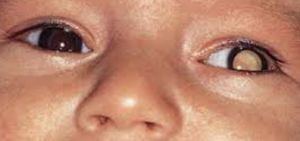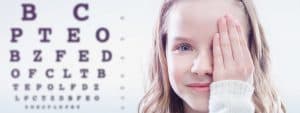Each year, over 14,000 cases of ROP are diagnosed in the U.S. alone, affecting 3.5% of premature infants.
While premature birth is the number one cause of retinopathy of prematurity (ROP), about 90% of all infants diagnosed with this eye disease will develop normal vision, without any treatment.
With time, mild cases of ROP typically resolve on their own— though these premature infants will continue to be at risk of developing other eye conditions throughout their lifetime.
Which eye conditions are associated with ROP?
Retinopathy of prematurity increases a child’s risk for developing retinal detachment, myopia (nearsightedness), strabismus (crossed eyes), amblyopia (lazy eye), and glaucoma in the future.
Fortunately, many of these conditions can be treated with glasses, vision therapy, specialized eye drops and/or surgery— though early detection is key.
As a result, regular eye exams are recommended to protect your child’s eye health and vision.
Retinal detachment
Each year, over 28,000 cases of retinal detachments are diagnosed in the U.S.
Retinal detachment occurs when the retina separates from the back of the eye, causing partial or total vision loss.
This eye condition is more often caused by later stages of ROP, though it continues to be a threat throughout the child’s lifetime.
Fortunately, with early detection, a retinal detachment can be treated with surgery to prevent permanent vision loss.
Myopia
More than 30 percent of the U.S. population has been diagnosed with myopia.
Myopia (nearsightedness) occurs when light is focused in front of the retina, instead of directly on it, resulting in blurred distance vision.
This is a common vision condition that can be corrected with glasses or contact lenses, though progressive myopia can lead to sight threatening vision conditions in the future.
Fortunately, myopia management is an effective program to help slow down the rate of myopia progression and sometimes even stop it completely.
Strabismus
Strabismus affects about 4 out of every 100 children in the United States.
Strabismus is characterized by an eye turn or a misalignment of the eyes. This vision condition causes one eye to turn in, out, up or down, and leads to suppression of vision in the affected eye— often resulting in a partial or total loss of stereo vision and binocular depth perception.
Strabismus is generally treated with a combination of surgery to realign the eyes, and vision therapy to improve binocular vision.
SEE RELATED: Retinopathy of Prematurity: FAQs
If your baby was born preterm, schedule an appointment with an eye doctor near you to ensure your baby’s eyes are healthy.
Amblyopia (lazy eye)
Lazy eye affects up to 3 out of every 100 children in the United States.
This vision condition leads to impaired visual acuity and visual skills in one eye, which can not be corrected with eyeglasses or contact lenses. Lazy eye typically causes a loss of stereoscopic vision (3D) and depth perception.
Vision therapy is often recommended to strengthen the neural connections and restore vision in the affected eye.
Glaucoma
Glaucoma is the number one cause of permanent blindness, worldwide.
Glaucoma is a group of progressive eye diseases that causes permanent vision loss.
Glaucoma occurs when the optic nerve, responsible for carrying visual signals between the eye and brain, becomes damaged— most commonly as a result of high intraocular pressure.
Glaucoma is typically treated with medicated eye drops or surgery to reduce eye pressure and prevent permanent vision loss.
LEARN MORE: Guide to Pediatric Eye Conditions
If your baby was born preterm, schedule an appointment with an eye doctor near you to ensure your baby’s eyes are healthy.
Retinopathy of prematurity can put your baby at risk of eye conditions in the future.
If your baby was born with ROP, it is crucial to monitor their eye health by bringing them for a comprehensive eye exam each year.










